Memory Beta, non-canon Star Trek Wiki
A friendly reminder regarding spoilers ! At present the expanded Trek universe is in a period of major upheaval with the continuations of Discovery and Prodigy , the advent of new eras in gaming with the Star Trek Adventures RPG , Star Trek: Infinite and Star Trek Online , as well as other post-57th Anniversary publications such as the ongoing IDW Star Trek comic and spin-off Star Trek: Defiant . Therefore, please be courteous to other users who may not be aware of current developments by using the {{ spoiler }}, {{ spoilers }} OR {{ majorspoiler }} tags when adding new information from sources less than six months old (even if it is minor info). Also, please do not include details in the summary bar when editing pages and do not anticipate making additions relating to sources not yet in release. THANK YOU
- Memory Beta articles sourced from short stories
- Memory Beta articles sourced from eBooks
- Memory Beta articles sourced from video games
- Memory Beta articles sourced from games
- Memory Beta articles sourced from Star Trek Online
- Memory Beta articles sourced from RPGs
- Non-humanoid species
- Races and cultures
- Alpha and Beta Quadrant races and cultures
- Federation races and cultures
- Telepathic species
- 1.1 Reproduction
- 1.2 Maturation
- 3.1 Alternate timelines
- 4 Known individuals
- 5.1 Connections
- 5.2.1 Appearances
- 5.2.2 References
- 5.3 External link

Biology [ ]
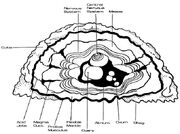
Internal anatomy of the Horta
The Hortas' preferred habitat was amongst the rock of a planet, though they could survive in a typical atmosphere , they found it disconcertingly empty to the touch.
The exterior of a Horta consisted of a brown rocky carapace which was highly resistant to damage; anything but the highest phaser settings felt like nothing more than a mild irritation to the Horta. On their underside, Horta had numerous cilia which they moved about on.
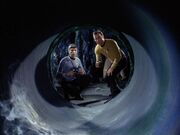
A Horta tunnel
The Horta diet consisted of minerals which they dissolved with a powerful orange acid they secreted from glands all over their bodies; this acid was also the means by which Horta could tunnel through their rocky environment as easily as a humanoid might walk through air. When Horta were afraid, they would lose control of their acid glands and squirt the powerful corrosive all around them. They also have the urge to tunnel to safety, although they can suppress this instinct when needed, such as to not damage the deck plates of a Federation vessel.
Horta sensory organs included the ability to quite specifically detect the chemical composition of materials around them so they could target the most desired minerals. This form of sensory input dominated the Horta's perception of the world, being able to tell what gases made up the air that surrounded them and identifying species by the chemical composition of their blood.
Horta could survive exposure to the vacuum of space , though the shock resulted in a temporary coma . Horta could also happily eat through power conduits, quite unaffected by energies and radiation passing through them. They were equally invulnerable to shields, being able to easily pass through them. ( DS9 novel : Devil in the Sky ) However, they were not able to survive pure magma , in which they would dissolve in minutes or seconds depending on the surrounding temperature. ( TOS novel : Devil's Bargain )
They had poor eyesight and could mostly see in the Infrared spectrum. Their method of hearing involves detecting atmospheric vibrations, and they had a highly developed sense of smell that was used in one of their means of communication.
They also had something of a clan mind and a hive mind, which was a stage on their way to further development into individuals. This hive mind is broken when the All Mother dies. Although telepathic contact would still be possible, especially among clans, the hive mind would break, leaving their mental state isolated from each other. They also had a semi-telepathic bond that communicated feelings rather than intelligent thought. ( TOS novel : Devil's Bargain )
Reproduction [ ]
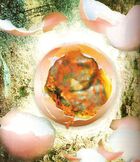
A hatching Horta
The Horta were extremely long lived, had no natural predators and were practically indestructible; as a result, over time, Horta populations grew substantially. As a means of population control, once every 50,000 years the Horta underwent a mass self induced extinction; the renewal .
Before each renewal the Horta laid their eggs in the Vault of Tomorrow and left a single caretaker, the Prime Mother , to see the next generation into the world.
The Horta also laid eggs between renewals, breeding like any other species. ( DS9 novel : Devil in the Sky )
The Hortas employed selective breeding to steadily improve themselves by choosing the best of their generation to be the Prime Mother, resulting in their species being remarkably civilized and intelligent. ( TOS novel : The Rise and Fall of Khan Noonien Singh, Volume 1 )
They also had genitalia on their undersides. This would show that they were male or female, although a Human would not know their sex unless they spent enough time with them or they show their undersides. ( TOS novel : Devil's Bargain )
Maturation [ ]
Newborn Hortas would burn out of their eggs as fleshy red wormlike creatures, about half a meter long. They quickly developed their rocky armor as they grew. Acid of young Horta is not as strong as that of adults.
Young Horta begin to eat as soon as they are born and quickly grow, reaching adult sizes in a matter of days. ( DS9 novel : Devil in the Sky )
When a Horta was about to die, its rocky skin becomes smoother and less bumpy. ( TOS novel : Devil's Bargain )
Culture [ ]
Within their planet lies repositories of their memories written into crystals that were part of the structure of the rock itself which told Horta history. ( TOS novel : Devil's Bargain ) An example of one of these repositories was the Stone of Memory . ( DS9 novel : Devil in the Sky )
The renewal was a major element of Horta culture, the Prime Mother (also known as the All Mother) of each new renewal was a significant figure in each generation of Horta and the young hoped to achieve the privilege of becoming the next Prime Mother at the next renewal. Being the parent (or possibly as far back as a living ancestor) of the next chosen Prime Mother is also considered a high honor and a source of great pride in and of itself. ( DS9 novel : Devil in the Sky ) The All Mother was a specialized being, with only one born a generation. When her work was done, which was making a new generation, her biology shuts down and the young become individuals. ( TOS novel : Devil's Bargain )
The Horta were not capable of spoken speech: they had no mouth, but could communicate by producing rumbling sounds. They could communicate with themselves with smells and psionic waves that allows mental communication. ( TOS novel : Devil's Bargain ) For ease of communication with humanoids Horta could be fitted with universal translators . Horta were also taught to communicate by etching text into the ground should their translator malfunction. ( DS9 novel : Devil in the Sky ) Such was the case when first contact was made by the Mother Horta. Using fractured English language from mind melding with Spock , she etched " No Kill I " to express her unwillingness to die, nor cause death. ( TOS episode : " The Devil in the Dark ") Before the use of the universal translator, the miners of Janus VI used colored marbles that when placed in certain orders could make codes that both sides could translate. They also used a type of wiggling movement, similar to what a bee does, to communicate. ( TOS novel : Devil's Bargain )
After the new Horta hatched, they formed clans based on the caste that they were born into and their specialized genomic strengths. Some examples of these clans were the Tunnel Borers and the Hole Diggers . These clans had competition in the way that when one clan works harder than all the rest, this earns them more love from the All Mother. ( TOS novel : Devil's Bargain )
Some Horta adorned themselves with rocks for decoration, giving them a blue or green tint instead of regular brown. They were able to "applaud" like other species, except their version consisted of clacking, shuffling, and whistling that sounded like steam. They were interested in profit, using what they earned along with the miners to buy rocks and minerals from other planets , which they considered delicacies. They also had their own myths, with the All Mother telling her children stories about mythical creatures such as lavagoblins and the Ghost-in-the-Rock . ( TOS novel : Devil's Bargain )
History [ ]
Some time prior to the 23rd century , the Borg visited Janus VI; fortunately they did not recognize the Horta as any sort of lifeform and left without attempting assimilation . ( ST comic : " A Rolling Stone Gathers No Nanoprobes ")
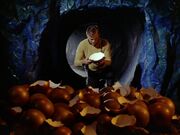
Captain Kirk examining a damaged Horta egg in the Vault of Tomorrow
In the 23rd century the Horta entered into a renewal. While Janus VI appeared uninhabited, the Federation established a mining colony, which the Prime Mother tolerated until 2267 . In that year, the miners opened new levels of the mines and damaged eggs in the Vault of Tomorrow . The Prime Mother tried to protect the eggs and killed fifty of the miners, who were not aware of the damage they had done. The mysterious deaths resulted in the USS Enterprise being sent to investigate. Captain James T. Kirk and his first officer Spock conducted first contact with the Horta, Spock communicating via mind meld , and learned why the creature had attacked the miners. ( TOS episode : " The Devil in the Dark ")
After the misunderstanding was resolved, the remaining Horta eggs hatched, and the species began to thrive once more. By 2300 , there were nearly 1,100 new Horta on Janus VI, and fifty years later , there were more than 3,000. The Horta and Humans worked together on the mining operation, which became one of the most productive and profitable operations in the known galaxy, sourcing raw ore and rare elements to the entire Federation. ( ST short story : " Mother's Day "; DS9 novel : Devil in the Sky )
Two years after the discovery of the Horta, some of their members were chosen to help save the planet Vesbius from an incoming asteroid . This was the first time that any of their race left their planet. However, before anything could be done, a problem had to be solved first. Instead of the All Mother dying so the children could grow as a species, the children became dependent on her and kept her alive by feeding her offworld minerals. So a proposal was made: when the job was done, Spock (who was able to communicate with them telepathically) would become the new All Mother. But after all the events have happened, Spock (whom allowed the children to call him the "All Father") showed them the error of their ways and that they could not be dependent on their mother or anyone else if they were to grow as a species. ( TOS novel : Devil's Bargain )
The Horta- Human mining alliance soon spread to other planets : the first planet found suitable for mining and the dietary requirements of the Horta was Lythos Prime . The operation on Lythos quickly gained a reputation for always meeting its quotas on time. ( ST comic : " A Rolling Stone Gathers No Nanoprobes ")

Horta Lieutenant Naraht in 2285 .
Dahai Iohor Naraht , one of the first Horta hatched, went on to join Starfleet . ( TOS novel : My Enemy, My Ally )
Other young Horta to enter Starfleet Academy included Slider Dan , Missile-in-Rock , Crumblecake and Hot-John , four named members of a newly-formed, five-member Star Clan , following an incident on the Enterprise , in which the five are blown out of the shuttle bay into space and must group together to await rescue. ( TOS novel : Devil's Bargain )
Doctor Brewster was the Horta leader of a scientific survey on Pegasus IV . ( TOS novel : The Starship Trap )
In 2305 , the Horta Sanaht began representing Janus VI on the Federation Council . ( ST novel : Articles of the Federation )
One of the Dax symbiont 's hosts was involved in operations working with Hortas to mine planetary cores . ( DS9 novel : Devil in the Sky )
In 2369 , the Horta-Human operation on Lythos Prime was attacked by a Borg cube whose sensors had mistakenly detected a carbon -based/ silicon-based hybrid species on the planet, kelbonite deposits giving false readings of the Humans and Hortas. After realizing their error, the Borg attempted to assimilate the Horta, but were unable to as the Horta dissolved the drones' injection tubules on contact. Effectively resisted, the Borg retreated. ( ST comic : " A Rolling Stone Gathers No Nanoprobes ")
In 2370 , the Horta-manned starship USS Darwin , commanded by Captain Dalen , assisted the USS Enterprise -D in exploring the dyson sphere the latter vessel had discovered the previous year. ( TNG novel : Dyson Sphere )
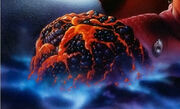
The Horta Ttan
Also in that year, the Horta Ttan and her family (at the time a clutch of eggs) were recruited to assist in rebuilding Bajor 's mining industry, which had been devastated in the Occupation . Unfortunately as the ship transporting the Horta family approached Deep Space 9 , it was ambushed by a Cardassian vessel , and Ttan was kidnapped. Ttan was rescued shortly after, but returned to find her children hatched, but no home on Bajor as the Council on Ecological Controls refused to let the Horta settle. Instead Ttan and her family were permitted to take up residence on Bajor's moon Baraddo where they found many valuable mineral deposits. ( DS9 novel : Devil in the Sky )
In 2371 , Captain Jean-Luc Picard , Spock , and Dr. Lewis Zimmerman attended a ceremony on Janus VI in which Tetsua , the mother of the next generation of Horta, was installed. ( TOS short story : " Tears for Eternity ")
In 2376 , the USS da Vinci aided in stopping a Horta plague on Janus IV. ( SCE eBook : Ambush )
In 2379 , the Horta Chwolkk became an engineer on the USS Titan . ( TTN novel : Taking Wing )
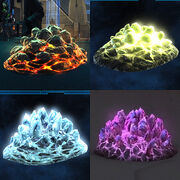
Horta variations in 2409: regular Horta, polytrinic acid Horta, eisilum crystal Horta, dilithium Horta.
In 2409 , there were some Horta influenced by various minerals, producing variations in the species. Such variants included the polytrinic acid Horta, the eisilum crystal Horta, and the dilithium Horta. ( STO - Romulan Mystery mission : " Mine Enemy ")
In 52,267 , Tetsua witnessed the hatching of the next generation of Horta. ( TOS short story : " Tears for Eternity ")
Alternate timelines [ ]
In an alternate timeline , the Horta became the guardians of the Guardian of Forever in 2464 . ( ST short story : " Guardians ")
Known individuals [ ]
- Chawal Nurel
- Chitan Onaka
- Crumblecake
- Dahai Iohor Naraht
- Dahen Tetsu
- Dalai Naran
- Missile-in-Rock
- Salak Johan
- Tetsu Nelek
- Tulek Melsu
Appendices [ ]
Connections [ ], appearances and references [ ], appearances [ ].
- TOS episode : " The Devil in the Dark "
- TOS novel : Devil's Bargain
- TOS novel : My Enemy, My Ally
- TOS novel : Spock's World
- TOS novel : The Romulan Way
- TOS novel : Swordhunt
- TOS novel : Honor Blade
- TOS novel : The Empty Chair
- TOS movie : Rules of Engagement
- TOS novel : Time for Yesterday
- TOS comic : " Double Blind "
- TOS comic : " Aspiring to be Angels "
- TOS video game : The Kobayashi Alternative
- DS9 novel : Devil in the Sky
References [ ]
- FASA RPG module : The Federation
- Decipher RPG module : Worlds
External link [ ]
- Horta article at Memory Alpha , the wiki for canon Star Trek .
- 1 Achilles class
- 2 Ferengi Rules of Acquisition
- 3 Odyssey class
- More to Explore
- Series & Movies
Published Jan 3, 2017
Horta, Humpbacks and the Encounter at Farpoint
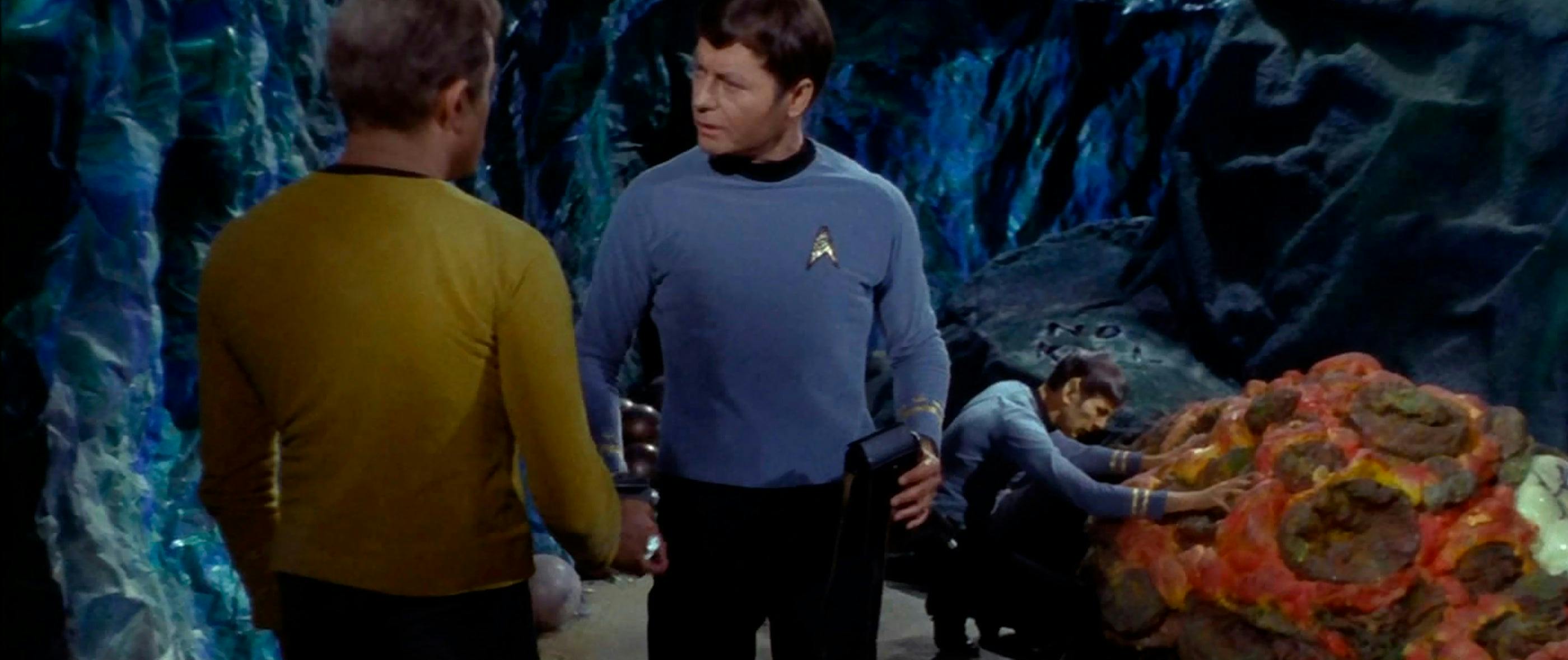
Gene Roddenberry’s vision of the Star Trek universe was one where humanity overcame the violence and prejudices that have plagued much of its history and unified in a vision of equity, exploration, and a just society. Star Trek has consistently been at the forefront of addressing important social issues. These include issues of race, American identity, torture, the relationship between religion and society, the ethics of war, and dialogical approaches to diplomacy. One area that has not received much formal attention is how Star Trek includes other animals in its ethical purview. While this aspect of Trek ’s vision has been less central to the impact of this cultural phenomenon, it has been consistently addressed across multiple series. This was seen early in Star Trek: The Next Generation , when it was revealed that the food replicators addressed not only the pragmatic issue of food and prolonged space travel, but it had a moral rationale as well. In the episode, “ Lonely Among Us ,” Commander Riker says to the Antican ambassador, “We no longer enslave animals for food purposes.” In giving a moral rationale, acclaimed Trek writer D.C. Fontana intended to offer ethical insight into Starfleet’s ethics. Other animals are not simply products of human consumption, but beings whose moral relevance makes demands on human interactions with them. This concern for other animal species is illustrated at key moments throughout Trek ’s illustrious history. I will briefly address three instances where Trek put forward innovative ethical discussions regarding other animals: the Horta, Humpback whales, and the creatures at Farpoint Station.
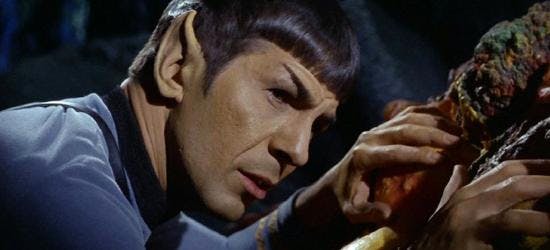
In The Star Trek: The Original Series episode, “ The Devil in the Dark ,” Kirk, Spock and McCoy reach a human mining colony where a creature has killed several of the human workers. It is soon discovered that human industrial practice has placed this species at risk. The Horta, a mother who is the last of its kind, is defending her eggs which are in jeopardy from the mining activities carried out by humans to meet energy needs. Kirk labels the Horta a “monster” when he learns of the deaths of some miners. It is after the Horta removes and hides a key mechanical piece that Kirk calls her a “creature” (1) and shows disdain for the leader of the miners’ ongoing use of the monstrous nomenclature. After wounding the Horta, Kirk attempts to communicate with it. The creature moves forward when Kirk speaks and recoils like a wounded animal when Kirk raises his phaser. In this scene, Kirk is expanding his consciousness as to what constitutes morally relevant life.
However, it is only with Spock’s mind meld that the viewer fully understands the full thrust of the episode’s message. Through Spock’s turning the pain and psychological state of the Horta into words, the Horta speaks. “The thousands… devils! Eternity ends! The chamber of the ages! The altar of tomorrow! Murderers! Stop them! Kill! Strike back! Monsters!” With these words, we understand who is to be identified as the devil in the dark and who is truly monstrous. The devil is not the Horta, but humans who encroach upon the natural habitat of the animal and jeopardize its existence through need for industry. The devil is we who treat animals and nature as we see fit in our quest for expansion and consumption of materials. The Horta and the miners strike a deal which is profitable for both. At this point in Trek ’s development there is still no need to curb industry profitable to humans and the animal can be used to aid human expansion.
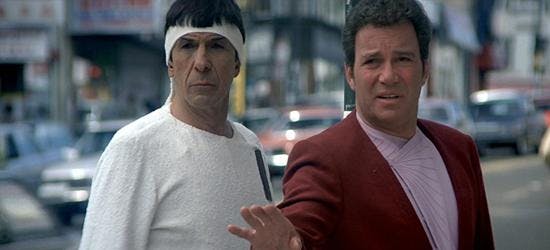
These themes are taken further with the fourth motion picture in the Star Trek movie franchise: The Voyage Home . The instrumentalist conclusion of “The Devil in the Dark,” where the humans concede to co-existing with the Horta provided it remains profitable, is challenged with Spock’s logic. The Vulcan says to Kirk, “To hunt a species to extinction is not logical.” Spock counters the instrumentalist narrative that humanity constructs for its unfettered use of other species. For it to be illogical to hunt a species to extinction there are two possibilities. First, human use of the species is no longer possible after extinction and so it is illogical for humanity to harm itself and limit the benefit it may receive from an animal. Second, it could be illogical because the moral value of another species of animal is not derived from its benefit for humans. It seems that Spock has the latter in mind when he says to Kirk, “Admiral, if we were to assume these whales were ours to do with as we pleased, we would be as guilty as those who caused their extinction.” Here Spock argues against an act saving the Humpback whales if it is simply to use this species as instruments for human benefit. Contrary to Immanuel Kant, Spock argues that animals have direct value by virtue of their own existence, and not merely indirect value by virtue of their benefit to humans.
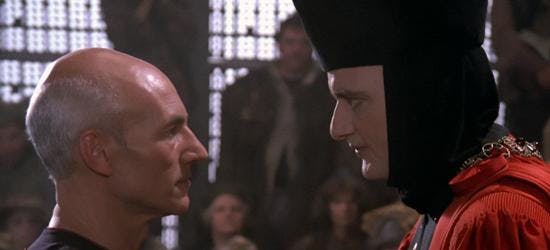
Finally, in the pilot episode of TNG , the new crew is forced to stand as proxy in a mock courtroom by the omnipotent Q, who is putting humanity on trial. The challenge Q puts before Picard is the mystery of Farpoint station, which appears to inquire how the Bandi colony can power such a place with limited technology. It is only at the conclusion of the episode that viewers are exposed to the possibility that humans are being tested not only on their cognitive potential, but also their moral potential. As the space animal (Picard refers to it as a “creature”) attacks the colony, Groppler Zorn implores Picard to do away with it as it is killing his people. Picard simply asks whether it has reason to do so. The Bandi were using the wounded creature’s ability to convert energy to matter in order to advance the industrial capabilities of the humanoids. Picard declares that this is not a good enough reason to advance the suffering of the animal. The final test comes from Q, who presses the captain, “Save yourself, it may attack you now… make phasers and photon torpedoes.” At the conclusion, the audience realizes that humanity is judged not only on its ability to solve puzzles, but even more how it responds to a wounded animal and the threats of its mate.
In these examples, we see Star Trek ’s expanding moral inclusivity regarding other animals. In moving from an instrumentalist approach to other animals to recognition of their dignity independent of humanity, Star Trek continues to challenge one of the more pressing moral questions of our day: how are we to treat other animal species? Star Trek , in its various iterations, challenges its audience to consider the potential of the moral dignity of other animals and our relationship to them. In a world that has lost half of its vertebrate wildlife in the last 40 years due to human activity, Star Trek challenges us to change our approach to other animal species. (2)
Let us make it so.
1. When Star Trek refers to a "creature" it generally invokes the notion of an animal. When beings with greater communicative powers with hominoids are intended the language used is typically "entity" or "being."2. Living Planet Report 2014: Species and Spaces, People and Places . no. 1, World Wildlife Federation International, 1-180.
Get Updates By Email
Navigation menu
- Mission Logs
- Chronologies
- Library Computer

Native to Janus VI , Horta were a silicon -based species that fed on rock and secreted highly corrosive acid that allowed them to digest it as well as to easily travel through it. Their skin was once compared to asbestos . Each generation of Horta would hatch from a clutch of thousands of eggs , cared for by a single Mother Horta from the previous generation. At the end of their life span, they would all die off, save for a single Mother Horta that would care for the next generation. Gestation within the eggs took approximately fifty thousand years. The eggs were perfectly round and approximately 250-300 cm in diameter, and were initially mistaken as silicon nodules and a geological oddity when first discovered by the Federation mining colony that was established on Janus VI. Horta began tunneling immediately after hatching. [1]
Image Gallery

Horta eggs ( TOS 26 )

Notes and References
- ↑ Roddenberry, Gene ( Executive Producer ). "The Devil in the Dark." Star Trek , Season 1, Episode 25 (Production 26). Directed by Joseph Pevney . Written by Gene L. Coon . Desilu Productions , 9 March 1967 .
- Prime Timeline
- Privacy policy
- About Trekipedia
- Disclaimers
- Login / Create Account
- Lithotrophs
- Hive Species
- Silicon-based Species
- 1967 Debuts
- Live Action Species
- Aliens Portrayed by Janos Prohaska
- Oviparous Species
- Species Created by Gene L. Coon
- Species with Multimillennial Lifespan
- Telepathic Species
- 1.1 Life cycle
- 3 Appearances
Biology [ ]
They secrete a powerful, corrosive acid, which allows them to dig perfectly round tunnels and move through them while feeding on rocks and minerals. They do not breathe oxygen, but are not harmed by it either.
Despite their somewhat sluggish appearance, the Hortas have demonstrated great speed and flexibility, as well as resistance to phaser shots.
Life cycle [ ]
Hortas live for 50,000 years, and then they all die, except for their leader, the Mother Horta, which takes care of the eggs, making sure that the next generation of Hortas will be safe. Horta eggs are brown spheres composed almost entirely out of silicon.
History [ ]
Hortas were the first silicon-based lifeforms officially recognized by science. Before their discovery, it was believed that silicon-based life was pure imagination. They were discovered in 2267, when Human miners found the Horta eggs and destroyed them, believing them to be nothing but rock. In order to protect the remaining eggs, the Mother Horta attacked the miners' colony. At the end, it was decided that the Hortas and their eggs would be left alone, and the Hortas agreed to help the miners by creating access to the planet's large mineral deposits. Eventually they would join the Federation
Appearances [ ]
- Star Trek , s01e26, "The Devil in the Dark" (1967)
- 1 Xenomorph
- 3 Mala'kak

Mother Horta
When the Federation established a mining colony on the planet in the 2210s , the mother Horta initially tolerated the presence of the miners . But when automated machinery broke onto level 23 in 2267, destroying thousands of Horta eggs in the Vault of Tomorrow , the mother began to fear for her children. She retaliated by destroying parts of the machinery with her powerfully corrosive acid , and when a maintenance engineer came to repair it, she killed him.
Three months later, by stardate 3196, she had killed over fifty people, including five guards (such as Schmitter ) placed to stop her. Pergium production on the colony had been driven to a standstill. Colony administrative head Vanderberg summoned the USS Enterprise for assistance, as the colonists could not locate or harm what they believed to be a mere animal. Enterprise science officer Spock deduced that the reason for this was because they were combating a silicon -based lifeform, which has been previously thought mere fantasy. He was able to modify the hand phasers of Enterprise personnel to function against silicon lifeforms.
Spock and Captain James T. Kirk were able to harm the mother Horta after it killed a security officer , but it escaped through a freshly made tunnel. Shortly thereafter, Kirk encountered it once more, but wounded, the mother did not attack him. Spock was able to initiate a mind meld with her, and using the knowledge she gleaned from the meld, she used acid to write "NO KILL I" in the cave floor. Spock revealed that the creature was actually a sentient creature protecting her children.
The mother had stolen the main circulating pump from the colony's PXK pergium reactor , but in exchange for the return of the pump, Doctor Leonard McCoy was able to heal her phaser wound with thermal concrete . Once the situation was explained to the miners, they were suitably remorseful, but Spock negotiated an agreement between the Horta and the colonists via the mind meld. The colonists would leave the Horta eggs alone, and the Horta would use their abilities to assist in mining operations.
Spock reported that the mother Horta had an extremely logical mind, and though she found the humanoid form displeasing to behold, she thought she could get used to it. Her favorite aspect was the pointed ears; Spock could not bear to tell her that not everyone had them. ( TOS : " The Devil in the Dark ")
In 2381 , a framed photograph of the mother Horta after it had just emerged through a rock face was among several others displayed on the walls of a bar on Starbase 25 . ( LD : " An Embarrassment Of Dooplers ")
Appendices [ ]
Background information [ ].
The mother Horta was played by Janos Prohaska . Much of the information about the Horta's life cycle comes from the words of the Horta mother.
Producer Robert H. Justman recalled how Prohaska, who had created the Horta costume himself, made the pitch for the role:
We made a " spec " deal with Janos. If he came up with a really great creature for a script Gene Coon was writing, we'd rent it and hire him to play the part. Janos was back within a week's time with his custom-designed creature. It was a large pancake-shaped glob of gook with a thickened raised center and fringe around its circumference. It sure didn't look like much. As Janos took the glob out of sight to put it on, Gene Coon raised an objection "Bob, why are wasting time with this?" Suddenly, the blob skittered around the corner, making straight for us. Then it stopped, curiously, backed away, and rotated in place. The blob gathered itself up, quivered, made a whimsical up-and-down movement, grunted, and skittered away again – leaving behind a large, round white "egg". Coon was dumbfounded. He watched the creature giving birth. And when the creature suddenly turned and scurried back to nuzzle its "child", Gene was sold. "Great!" he exclaimed, "It's perfect! Just what we need." Then he excitedly hastened back to his office to finish writing the script. Gene Coon's "The Devil in the Dark" became one of Star Trek 's most famous episodes. And Janos Prohaska played his own creation, one of Star Trek 's most famous creatures, the highly imaginative and custom-designed mother Horta." ( Inside Star Trek: The Real Story , pp. 214-215)
What neither Justman nor Coon had realized at the time however, was that Prohaska had actually already created the creature previously for The Outer Limits , first appearing in the final episode, and that he had only slightly modified the rubber costume with veins and the "fringe" for its Star Trek appearance. ( Star Trek: The Magazine Volume 3, Issue 9 , p. 73) Titled "The Probe" (with Peter Mark Richman ), the Outer Limits episode's storyline was about survivors of a plane crash in the Pacific waking up to find themselves (and their life raft) on the floor of an alien spacecraft sent to collect terrestrial lifeforms . In this episode, broadcast in January 1965 , the future Mrs. Horta was performing yeoman service as a giant cold germ threatening the hapless Earth people. ( The World of Star Trek , 3rd ed., p. 74)
External link [ ]
- Prime Mother at Memory Beta , the wiki for licensed Star Trek works
- 1 USS Enterprise (NCC-1701-G)
- 3 Daniels (Crewman)
The Mother Horta , born around 44,773 BC, was the last of the Horta species of Janus VI until stardate 3196 in 2267. Every 50,000 years every Horta dies except for one, who watches the eggs until they begin to hatch.
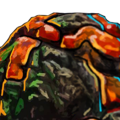
External Links
- Mother Horta at Memory Alpha
- Pages using DynamicPageList parser function
- Appears in The Original Series
Navigation menu
- Items that Bind on Pickup
- Unique Items
Polytrinic Acid Horta
- VisualEditor
The Polytrinic Acid Horta is an acidic silicon-based life-form first found on Janus VI. Hortas are difficult to detect with tricorders and their hardened skin is resistant to phaser fire. They tunnel through solid stone by secreting a corrosive acid that can also be used as a weapon. Usually found in caves and underground caverns, Hortas feed on the rocks and minerals found in their natural habitat. Horta are sentient and have life cycles that extend for thousands of years.
Stats [ | ]
Summons your Polytrinic Acid Horta ally. The Polytrinic Acid pet uses a much more toxic acid than the normal Horta. This acid will provide a slight increase in damage, but leaves the Polytrinic Acid Horta slightly weaker due to its more chemically reactive composition. The Polytrinic Acid Horta uses a basic attack that will apply acidic damage over time to its target.
- Targets Friend and Self
- 30.48 meter Range
- 0.25 sec activate
- 5 min recharge
- Creates a level X Polytrinic Acid Horta for 60 sec
Notes [ | ]
- 2 Typhoon Class Battleship
- 3 Infinity Prize Pack - T6 Ship

IMAGES
VIDEO
COMMENTS
A silicon-based race first found on Janus VI, Hortas are difficult to detect with tricorders due to their unusual life signs and their hardened skin is resistant to phaser fire. They tunnel through solid stone by secreting a corrosive acid that can also be used as a weapon. Usually found in caves and underground caverns, Hortas feed on the rocks and minerals found in their natural habitat ...
The Horta Hatchling is a non-combat pet available as an optional reward for completing "Mine Enemy". A young Horta has chosen to join you on your adventures! This silicon-based lifeform will learn from you as you travel and munch on any interesting metals or minerals it encounters. Someday your Horta friend will return to the Chamber of the Ages on Janus VI, but it has a few thousand years ...
The Horta Mineralogy Research is a crafting schematic reward from the mission "Mine Enemy". It allows you to train the Horta Hatchling to become a reusable c...
This unusually-charismatic and agile species once hailed from the planet Janus VI. Since their humble beginnings as silicon eggs, the Horta have grown to become key members of the Federation. Born tactical geniuses, the Horta will add a distinctive mark to any task force! These natural espionage agents can burrow through any wall or obstacle to ...
Sci-fi. Star Trek. The Horta Mineralogy Research is a crafting schematic reward from the mission "Mine Enemy". It allows you to train the Horta Hatchling to become a reusable combat Horta via the Duty officer system, as long as you also have 100 Duranium. This schematic details the interactions of various...
The series of Star Trek: Titan novels also has a male Horta character, Chwolkk (β), who serves as an engineer on the USS Titan. In the MMORPG Star Trek Online, in the mission "Mine Enemy", a Horta kills Tal Shiar officers and burns the words "NO KILL I, NO KILL I" into a cave floor with acid. If the player observes this, he or she will get the ...
Too long has their rocky past kept the Horta at the foot of the galactic table! This unusually-charismatic and agile species once hailed from the planet Janus VI. Since their humble beginnings as silicon eggs, the Horta have grown to become key members of the Federation. Born tactical geniuses, the Horta will add a distinctive mark to any task ...
What began as a misunderstanding on behalf of some miners led to a very profitable relationship between the devils in the dark and the Starfleet.But before a...
Here's something that me and MultiAwesome missed while doing the Mine Enemy mission, a Horta that was apparently inhabiting the mine.
The Horta were a silicon-based lifeform native to Janus VI and members of the United Federation of Planets. According to Spock, they were a very emotional as well as intelligent species who appreciate the strengths and differences of others, and they were a literate and tool-using species. The Hortas' preferred habitat was amongst the rock of a planet, though they could survive in a typical ...
These Prize Packs contain the prizes of the past, allowing you access to the weapons, items, and ships you may have missed over the years in Star Trek Online. You can see a full list of the prizes contained within, below! The Phoenix Prize Pack is a special pack, purchased with Dilithium (or obtained for free, during this event).
Too long has their rocky past kept the Horta at the foot of the galactic table! This unusually-charismatic and agile species once hailed from the planet Janus VI. Since their humble beginnings as silicon eggs, the Horta have grown to become key members of the Federation.
This unusually-charismatic and agile species once hailed from the planet Janus VI. Since their humble beginnings as silicon eggs, the Horta have grown to become key members of the Federation. Born tactical geniuses, the Horta will add a distinctive mark to any task force!
List of episodes. " The Devil in the Dark " is the twenty-fifth episode of the first season of the American science fiction television series Star Trek. Written by Gene L. Coon and directed by Joseph Pevney, the episode first aired on March 9, 1967. [1] In this episode, the Enterprise is called to investigate deaths at a planetary mining facility.
In The Star Trek: The Original Series episode, "The Devil in the Dark," Kirk, Spock and McCoy reach a human mining colony where a creature has killed several of the human workers.It is soon discovered that human industrial practice has placed this species at risk. The Horta, a mother who is the last of its kind, is defending her eggs which are in jeopardy from the mining activities carried ...
Each generation of Horta would hatch from a clutch of thousands of eggs, cared for by a single Mother Horta from the previous generation. At the end of their life span, they would all die off, save for a single Mother Horta that would care for the next generation. ... Star Trek, Season 1, Episode 25 (Production 26). Directed by Joseph Pevney ...
"ENEMY MINE"After uncovering some Remen data, we learn the location of their planned Thalaron attack and its a simple Romulan Mining colony. Under the preten...
Non-combat pet. The Dilithium Horta is an acidic silicon-based life-form first found on Janus VI. Hortas are difficult to detect with tricorders and their hardened skin is resistant to phaser fire. They tunnel through solid stone by secreting a corrosive acid that can also be used as a weapon. Usually found in caves and underground caverns, Hortas feed on the rocks and minerals found in their ...
"We are dealing with a silicon creature of the deep rocks. Capable of moving through solid rock as easily as we move through the air." ―Mr. Spock, about the Horta. Hortas are sapient, silicon-based lifeforms native to the caves of planet Janus VI. They secrete a powerful, corrosive acid, which allows them to dig perfectly round tunnels and move through them while feeding on rocks and ...
An acidic, silicon-based lifeform first found on Janus VI, Hortas are difficult to detect with tricorders and their hardened skin is resistant to phaser fire. They tunnel through solid stone by secreting a corrosive acid that can also be used as a weapon. Usually found in caves and underground caverns, Horta feed on the rocks and minerals in their natural habitat. Horta are sentient and have ...
The mother Horta, born around 44773 BC, was the last of the Horta species of Janus VI until stardate 3196 in 2267. Once every 50,000 years the entire Horta population died off, except for one, who remained to protect the eggs until they began to hatch. When the Federation established a mining colony on the planet in the 2210s, the mother Horta initially tolerated the presence of the miners ...
Active. (-44th) to 23rd Century. Actor. Janos Prohaska. The Mother Horta, born around 44,773 BC, was the last of the Horta species of Janus VI until stardate 3196 in 2267. Every 50,000 years every Horta dies except for one, who watches the eggs until they begin to hatch.
Sci-fi. Star Trek. This assignment is unique. 1 x [Horta Hatchling] 1 x [Horta Mineralogy Research] 100 x [Duranium] Does not require any participating Duty Officer. This assignment is available in all locations. It is obtained by using the Horta Mineralogy Research which gives you this assignment.
The Polytrinic Acid Horta is an acidic silicon-based life-form first found on Janus VI. Hortas are difficult to detect with tricorders and their hardened skin is resistant to phaser fire. They tunnel through solid stone by secreting a corrosive acid that can also be used as a weapon. Usually found in caves and underground caverns, Hortas feed on the rocks and minerals found in their natural ...